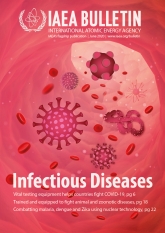Genetic sequencing is a nuclear-derived technique that analyzes the way in which nucleic acid — ribonucleic acid (RNA) and deoxyribonucleic acid (DNA) — information is arranged inside pathogens. This technique describes the composition of the genetic material, helping scientists to predict the function of the analysed gene, its impact and the behaviour of the pathogen. This not only helps to diagnose a disease but can also disclose its origin and evolution, as well as its potential threat.
Such nuclear-derived tools and techniques are frequently used for the phylogenetic analysis of FMD and other diseases such as rabies, brucellosis and Ebola.




